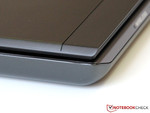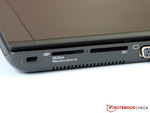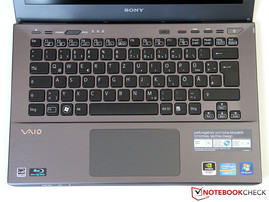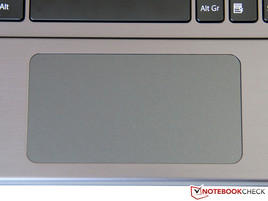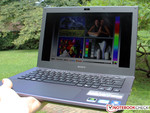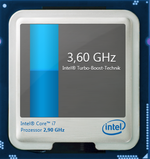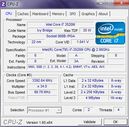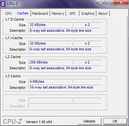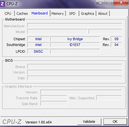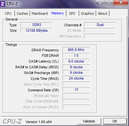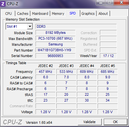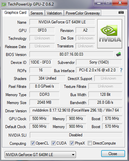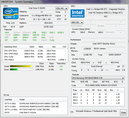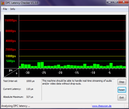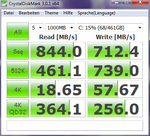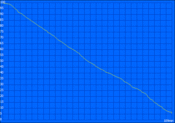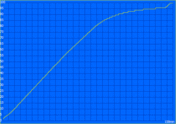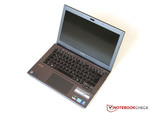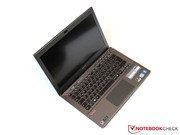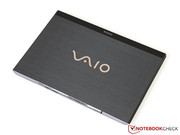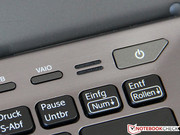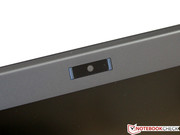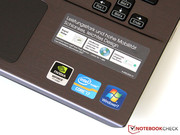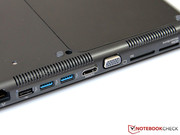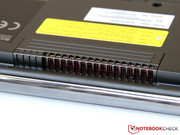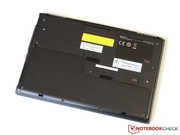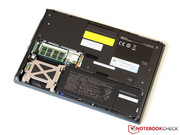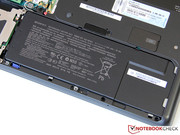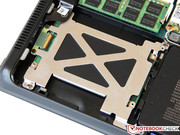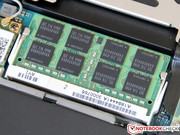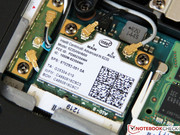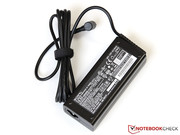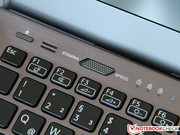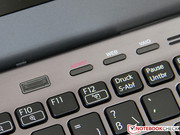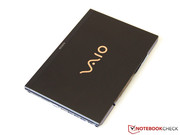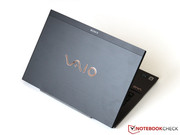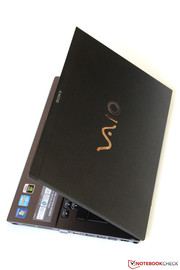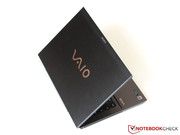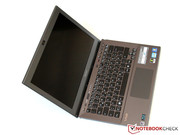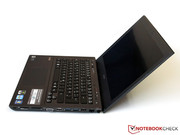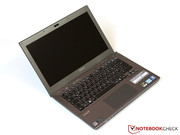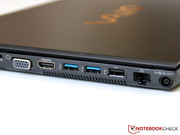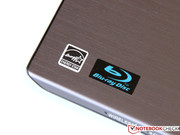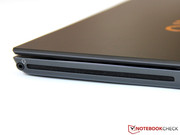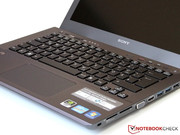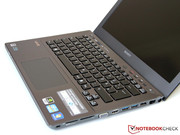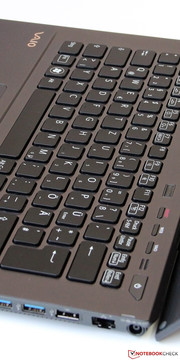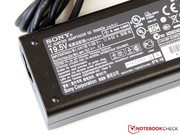Review Sony Vaio SV-S13A1Z9E/S Notebook

Famed Hungarian composer Zoltán Kodály wrote, “Only the best is good enough.” The Sony Vaio S series of business notebooks is designed specifically for corporate clients who demand this philosophy from their mobile work devices.
The entry point to this world starts at just over 800 Euro ($975 USD), a lot less than one might normally pay for models from the twice-as-expensive Z series. However, the price quickly soars beyond the entry point when higher configurations are selected.
Our test device, the Sony Vaio SVS-13A1Z9E/S, fits this description and is currently the most expensive notebook Sony has to offer with a price of almost 3000 Euro ($3660). At this price, one would certainly expect the crème de la crème state-of-the-art hardware and the Vaio SVS-13A1Z9E/S certainly does not disappoint.
The Vaio comes with the fastest Intel dual-core processor, the Core i7-3520M. The processor is supported by a gigantic 12 GB memory and the Nvidia GeForce GT 640M LE graphics card. The system is rounded out by an enormous 512 GB flash storage array, a built-in Universal Mobile Telecommunications System (UMTS) and Long Term Evolution (LTE) module, a Blu-ray writer, and a matte 13.3-inch screen.
The Vaio has no competition in this price range and other business notebooks, such as the Lenovo ThinkPad X1, Dell Latitude E6320 / E6330, and Toshiba Tecra R840, all fall short of the Sony notebook’s combination of high-end hardware.
Case
The Vaio SV-13A comes wrapped in dark-gray magnesium and carbon fiber and is a proper metaphor for an affluent business manager in a tailored suit. The exterior is restrained and only a few details, such as the glossy Vaio logo on the display lid and wrist rest, highlight the unobtrusive and potentially boring design. While the notebook gives an overall high-end impression, hardly anyone would be able to guess the notebook’s exorbitant price simply by looking at the exterior. This is perhaps a good thing as the device is designed for use on business trips.
The case has been modified slightly compared to our last test. The Vaio SV-S13A’s dimensions are now 22.8 x 331 x 225 millimeters (0.9 x 13.0 x 8.9 inches) and the notebook weighs 1.7 kilograms (3.7 pounds). The Vaio SV-S13A is thus a bit thicker and heavier than comparably sized ultrabooks. Nonetheless, the Vaio SV-S13A provides excellent mobility considering that a MacBook Pro 13 weighs over 2 kilograms (4.4 pounds).
Compared to Apple’s line of ultrabooks, the Vaio obviously cannot compete with the quality of a unibody case. While Sony has done an almost perfect job with edges and transitions, there is still room for improvement in a number of areas, including screen stability. A slight twisting is evident when the notebook’s display lid is opened at the outermost edge using only one hand. The hinges are precise and offer pleasant resistance but teeter a few millimeters when the notebook is placed on an unstable surface or the lap.
On the other hand, there are few complaints about the base unit. The case defies strong selective pressure but torsional stiffness could be better. Despite the very good overall performance of the case, other notebooks such as the Dell XPS 13 do better and set the standard.
Connectivity
While there is nothing remarkable regarding the connectivity of the Sony Vaio SV-S13A, the available interfaces cover most daily needs. Two of the three USB ports support the SuperSpeed USB 3.0 standard and are capable of gross data rates of up to 4 GBit/s. We tested the Corsair Flash Voyager 32 GB flash drive and reached its limit of 80 MB/s. We would need an external SSD to test even higher speeds. In contrast to the possible 30 MB/s via USB 2.0, this increase is nonetheless remarkable.
Two external monitors can be used via the VGA and HDMI ports. Since there is no DisplayPort connection, there may be issues for resolutions beyond 1920x1200. The Vaio also offers Gigabit LAN, two card readers that support SD, SDHC, SDCX, and MS Pro/Duo formats, and the usual combined microphone/headphone jack.
All ports except for the audio jack and the Blu-ray writer slot are located on the case’s right side and this could lead to space issues when using particularly broad connectors. Moreover, it is difficult to route monitor and network cables inconspicuously. We would have preferred to have these ports placed on the rear edge of the case.
Communication
The notebook uses the Intel Centrino Advanced-N 6235 WLAN adapter which supports the IEEE 802.11a/b/g/n protocols. This allows the Sony SV-S13A to use both the 2.4 GHz and 5 GHz frequency bands whereas cheaper modules generally lack support for the latter. The maximum gross data transfer rate is 300 MBit/s due to the 2x2 transfer support.
The mini-PCIe wireless module not only provides Wi-Fi and other wireless features such as Wireless Display (WiDi) but also supports the latest Bluetooth 4.0 functionality. Sony also includes a built-in Sierra MC7710 WWAN module that supports both the traditional UMTS/HSPA+ format and the higher-speed LTE standard capable of 100 MBit/s downstream and 50 MBit/s upstream.
While Sony boasts its “Exmor for PC” HD webcam, we found the picture quality a bit disappointing. Pictures and videos showed only moderate detail despite the listed 1.3 megapixel resolution. Visible noise and poor focus also affected the end result. The built-in microphone did slightly better but ultimately we can only recommend both components for video chats and similar applications.
Security
The notebook serves its business focus with a fingerprint scanner for secured login and a Trusted Platform Module (TPM) chip with support for the TCG 1.2 standard. The notebook comes with a one year license for Intel’s anti-theft service which allows the user to remotely lock the notebook in the event of theft, preventing secure and sensitive data from falling into the wrong hands.
Accessories
Despite the high price, the included set of accessories is quite meager. Apart from the notebook itself and its built-in battery, Sony only includes the 90 Watt power supply, various leaflets, and a dust cloth.
The SV-S13A comes pre-installed with Windows 7 Professional 64-bit, all necessary drivers, and a few programs. Amongst these programs, we found Microsoft Office 2010 Starter Edition, a trial version of McAfee's Internet Security, and various Sony service programs.
Maintenance
The Sony Vaio SV-S13A has a large maintenance cover on the bottom that can be opened after removing two screws. Removal of the cover allows access to the built-in battery, the Wi-Fi module, RAM, and SSD array. While all of these components are easily accessed and replaced, upgrading is rather difficult as the maximum memory capacity is already installed and the SSD array uses proprietary ports.
Warranty
The Vaio SV-13A comes with a standard one year base warranty. In light of the extreme cost of the notebook, the buyer may wish to extend the warranty to three years including pick-up and repair service from Sony for 129.90 Euro ($159 USD). For travel conscious or accident-prone buyers, the four year accidental coverage warranty may be preferable and is available for 349 Euro ($425 USD).
Input Devices
Keyboard
The Sony Vaio SV-S13A uses the same chiclet keyboard from other models such as the VPC-SA3X9E. This keyboard features a backlight and merges into the notebook’s base unit seamlessly. The black plastic keyboard uses 15 x 15 millimeter (0.59 x 0.59 inch) keys and has a high-end, slightly rubberized feel that allows for good grip despite the smoothness of the keys. Due to the size of the notebook, there is no number pad available. Three hotkeys are available above the keyboard which can be used to access the Vaio Care diagnostic software, the default web browser, and a predefined application of the user’s choice.
The excellent typing feel that we experienced in our previous review has not changed. All keys respond precisely throughout the entire key and have a well-balanced pressure point that provides the user with accurate feedback. We observed a high-pitched, quiet clattering when typing vigorously and found it to be annoying. This clattering slightly diminishes the otherwise great impression of the keyboard. Despite this, the keyboard has an overall high level of quality.
Touchpad
The Vaio SV-S13A uses an unusually wide touchpad with a size of 11.8 x 6.2 centimeters (4.6 x 2.4 inches). This size is quickly appreciated in practical use. The cursor can be moved across the entire screen without lifting one’s finger. The Synaptics touchpad has a subtly textured input area that has both good gliding traits and exemplary accuracy. Multi-touch gestures such as pinch-to-zoom and two-finger scrolling are supported.
We normally dislike mouse keys that are built directly into the touchpad’s lower edge. In this case, we must praise the crisp pressure point and immaculate build quality. Moreover the mouse cursor does not move unintentionally while clicking as in the Lenovo U300s.
Display
Compared to the Sony Z series, the Vaio SV’s screen is 0.2 inches larger at 13.3 inches and is only available in the 1690x900 WXGA++ resolution. This combination results in a high pixel density of 138 dpi which makes readability difficult but provides a generous desktop despite the notebook’s compact size.
While matte screens only need an average brightness in most situations, we were slightly disappointed by the display’s maximum brightness of 225 cd/m2. The previous model Vaio VPC-SA3XPE was about 10 percent brighter and had a slightly more homogeneous illumination.
| |||||||||||||||||||||||||
Brightness Distribution: 86 %
Center on Battery: 228 cd/m²
Contrast: 188:1 (Black: 1.21 cd/m²)
65.9% AdobeRGB 1998 (Argyll 3D)
89.3% sRGB (Argyll 3D)
70.4% Display P3 (Argyll 3D)
On the other hand, the display has a lower black value of 1.21 cd/m2, resulting in a 188:1 contrast ratio, slightly better than the previous model but still only comparable to entry-level models. The installed Sony SNY06FA TN screen does not seem appropriate for our configuration’s 3000 Euro ($3660 USD) price tag. For example, the somewhat less expensive Vaio VPC-Z21Q9E/B excelled in our test with a contrast ratio of far beyond 1000:1.
The SV-S13A also falls behind the VPC-Z21Q9E/B in color reproduction. While the Z series’ Full HD display almost completely covers the AdobeRGB spectrum, our test sample insufficiently covers the sRGB spectrum. This restriction may be marginal as users working with image processing or graphics programs will likely use external displays and this color limitation does not have practical restriction in office, multimedia, and gaming use.
In outdoor use, the screen’s matte display maintains the legibility of the screen’s contents despite its merely average overall brightness. Unfortunately, the SV-S13A becomes unusable in direct sunlight. A better score could have been achieved if the Vaio had a stronger LED backlight with a brightness in the 250 to 300 cd/m2 range. The extremely bright Samsung 900X3B serves as the measuring stick.
Due to its TN display, the Vaio SV-S13A suffers from the same viewing angle stability issues present in every other TN display. As is typical for TN displays, viewing angles to the sides are fairly generous but very limited vertically. Even slight deviations from head-on are enough to cause visible contrast changes and can only be remedied by adjusting the tilt of the display.
Lastly, the analog VGA port has an extremely flickering picture and the digital HDMI port should be used when possible.
Performance
While other manufacturers tend to equip their increasingly slimmer notebooks with energy-efficient ULV processors, the Vaio SV-S13A uses a standard 35 Watt processor.
Even though the quad-core Core i7-3612QM could be used for the SV-S13A, Sony limits the CPU to the dual-core processors from the Ivy Bridge family. Our test sample uses the fastest currently available dual-core on the market, the Core i7-3520M. The CPU is fabricated in the 22 nanometer process and has a high 2.9 GHz clock speed with a Turbo Boost speed of 3.6 GHz. The i7-3520M supports Hyper-threading technology, enabling the CPU to handle four threads simultaneously. The processor also supports modern extensions such as the advanced encryption standard (AES) and advanced vector extensions (AVX) from the Sandy Bridge family.
The processor shares its 4 MB L3 cache with its integrated graphics unit, the Intel HD Graphics 4000. While idle or during undemanding multimedia tasks, the HD Graphics 4000 handles the load while the Nvidia GeForce GT 640M LE takes over during 3D load thanks to Nvidia Optimus technology.
The centerpiece of the high-end impression is the combination of gigantic 512 GB flash storage and equally enormous 12 GB of RAM. The system memory consists of a built-in 4 GB module and an additional 8 GB DDR3L-1333 module in dual-channel operation. The DDR3L module requires only 1.28 Volts and results in lower power consumption when compared to standard DDR3 modules.
Processor
The standard-voltage processor should improve the SV-S13A’s overall performance but only does so with minor restrictions. The maximum possible 3.4 GHz Turbo Boost during full load throttles to the base 2.9 GHz clock speed after a few seconds. In the Cinebench R11.5 64-bit Multi-CPU test, the Core i7-3520M only managed 3.0 points and thus wasted nearly 15 percent of the CPU’s potential due to the above throttling. Regardless of this, the processor still marginally outperforms the fastest ULV model, the Core i7-3667U.
In our single-core tests, we did not observe any problems. The processor maintained a stable clock of 3.5 to 3.6 GHz. This allowed the system to achieve 6191 points in the Cinebench R10 64-bit single CPU test. This result is only the slightest bit behind the performance of exceedingly expensive Core i7-3920XM Extreme Edition. The processor is not throttled when operating on battery power.
Storage Devices
At first glance, merely the 512 GB of storage capacity is impressive when comparing our test sample to the basic model’s 320 GB hard disk. The fact that this storage capacity is made using a RAID 0 array of two 256 GB Samsung MZRPC512HAFU-000SO SSDs makes the storage solution even more impressive. Of course, this impressiveness comes at a hefty 1070 Euro ($1300 USD) premium.
We have previously tested these SSDs from the Vaio VPC-Z23N9E/B and they are likely based on a controller from the Samsung PM830 series. Unfortunately we could not find more detailed information. What we were able to determine is that the SSDs are connected via the SATA III interface and the performance of the RAID array is unmatched even by full-fledged desktop replacements. We determined sequential transfer rates of 844 MB/s for reading and 712 MB/s for writing using CrystalDiskMark. The array also yielded excellent performance during random access despite the fact that the RAID performance scales at a specific file size, namely the stripe size.
System Performance
In PCMark Vantage, the fast SSD array allowed our test sample to set a new record for dual-core notebooks with a score of 14496 points. The Vaio also achieved an excellent score of 3745 points in the newer PCMark 7 suite. This score is rarefied air even for gaming machines.
These benchmarks highlight the notebook’s very responsive and powerful performance in routine use. While certain tasks, such as video conversion, would be faster with a quad-core processor, the Core i7-3520M's performance is more than sufficient for virtually every application. We also observed an extremely short and impressive boot time of 13 seconds.
| PCMark Vantage Result | 14496 points | |
| PCMark 7 Score | 3745 points | |
Help | ||
Graphics Card
The Nvidia GeForce GT 640M LE which serves as the SV-S13A’s GPU is new for us as we have only previously tested the regular GT 640M. It appears the only difference between the LE version and the standard version is a somewhat lower core clock frequency of 500 MHz with a 570 MHz Turbo speed as compared to the GT 640M’s 625 MHz base clock and 709 MHz turbo clock. Both cards are based on the 28 nanometer Kepler GK107 chip which features 384 shader units and DirectX 11 support. The GT 640M LE comes with 2 GB of DDR3 VRAM in a 128-bit memory interface which should be more than enough even for demanding 3D games and applications.
Compared to the GT 640M, we observed a performance decrease of approximately 25 percent in line with the lower clock rate. Using the performance preset, we achieved a 3DMark 11 score of 1365 points which is marginally lower than the score of the GeForce GT 635M in the Asus N55SL that still uses the GF116 chip from the older Fermi architecture. The GT 640M LE is approximately 35 percent faster when compared to the Radeon HD 6630M in the previous model. As with the CPU, the GPU’s performance is not throttled when on battery power.
| 3DMark 03 Standard | 22952 points | |
| 3DMark 05 Standard | 15077 points | |
| 3DMark 06 Standard Score | 8543 points | |
| 3DMark Vantage P Result | 5528 points | |
| 3DMark 11 Performance | 1365 points | |
Help | ||
Gaming Performance
With every new graphics card, we take a particularly close look at gaming performance. Even though the Vaio SV-S13A is a business notebook and its gaming performance is of secondary importance, we remain interested to see what the GeForce GT 640M LE can achieve in terms of gaming performance.
We found that, depending on age and graphical requirement, the GT 640M LE is generally sufficient to smoothly render games at a resolution of 1366x768 in medium to high details. Games such as Fifa 12 and Diablo 3 (without anti-aliasing) were also rendered smoothly at 1920x1080, an exception among current games.
On the other hand, we observed difficulty in Battlefield 3, Alan Wake, and Risen 2. These three particularly demanding games were only playable using low settings at 1024x768.
The approximate 25 percent performance decrease between the GeForce GT 640M and the GT 640M LE observed in synethetic 3D benchmarks was also confirmed in games we tested. A comparable AMD model is the Radeon HD 6770M (identical to the 7690M XT) which uses the 40 nanometer fabrication process and thus has a higher power consumption.
| low | med. | high | ultra | |
|---|---|---|---|---|
| Metro 2033 (2010) | 58.4 | 37.5 | 19.1 | 6.6 |
| Dirt 3 (2011) | 144.4 | 70.4 | 51.1 | 16.8 |
| Deus Ex Human Revolution (2011) | 89.3 | 47 | 19.1 | |
| F1 2011 (2011) | 91 | 66 | 48 | 17 |
| Fifa 12 (2011) | 308.1 | 171 | 126.2 | 82.7 |
| Battlefield 3 (2011) | 38.1 | 24.6 | 20.3 | 8.9 |
| The Elder Scrolls V: Skyrim (2011) | 49.2 | 34.3 | 26.3 | 12.9 |
| Anno 2070 (2011) | 90.4 | 40.5 | 25.1 | 13.4 |
| Alan Wake (2012) | 42 | 25.2 | 11.2 | |
| Mass Effect 3 (2012) | 60 | 39.1 | 26.4 | |
| Risen 2: Dark Waters (2012) | 39.1 | 25.1 | 20.3 | 10.3 |
| Diablo III (2012) | 98.6 | 65.3 | 57.7 | 42.5 |
| Dirt Showdown (2012) | 73.8 | 55.1 | 36.1 | 13.4 |
| Max Payne 3 (2012) | 33.3 | 30.9 | 13.3 | 10.4 |
Emissions
System Noise
Despite its powerful hardware, the Vaio SV-S13A is virtually silent in practical use. The fan is permanently enabled even in the “Stamina Mode” but runs so slowly that its generated noise does not exceed 30.5 to 32.1 dB(A). Consequently, the notebook is barely audible to the user at a typical seating distance of 50 centimeters (20 inches) while idle. Hard disk access noise is also completely absent due to the SSD array.
While both the CPU and GPU are under load, the noise increases. We measured noise levels of 41.8 dB(A) in 3DMark06 and 47.6 dB(A) during our Prime95 and FurMark stress test. Although the fan emits a consistent and pleasantly low-pitched noise, this level is simply too loud for longer use. Fortunately, these levels will only be experienced in exceptional cases as this test was performed at a summer-like ambient temperature of 24 degrees Celsius (75 degrees Fahrenheit).
Noise level
| Idle |
| 30.5 / 30.8 / 32.1 dB(A) |
| HDD |
| 30.5 dB(A) |
| DVD |
| 36.4 / dB(A) |
| Load |
| 41.8 / 47.6 dB(A) |
 | ||
30 dB silent 40 dB(A) audible 50 dB(A) loud |
||
min: | ||
Temperature
While idle, Optimus and other energy-saving technologies keep the temperatures pleasantly low. The temperatures on both the top and bottom of the case were only 4 to 5 degrees Celsius (7 to 9 degrees Fahrenheit) higher than ambient temperature and barely increased during basic tasks.
During full load, the heat was centered on the vent area in the notebook’s center rear. We found this solution preferable as the waste heat is kept away from the user as much as possible. The wrist rest and large parts of the keyboard also remained fairly cool even during our stress test. This ensures that laptop use remains viable.
The internal components also did not reach excessive temperatures due to the efficient cooling system. The processor reached a maximum temperature of about 86 degrees Celsius (187 degrees Fahrenheit) after an hour and no throttling or stability issues arose. The graphics card heated up to roughly 71 degrees Celsius (160 degrees Fahrenheit) and throttled to 125 MHz as shown by GPU-Z. However, this may have been a readout error as the frame rate did not drop to this level in FurMark.
In practical 3D applications, we observed this throttling after longer loads. Metro 2033 ran at only half speed after running for a while. The higher ambient temperature of over 25 degrees Celsius (77 degrees Fahrenheit) at the time of the test likely contributed to this. We were able to eliminate the aforementioned throttling by elevating the notebook slightly.
(-) The maximum temperature on the upper side is 54.3 °C / 130 F, compared to the average of 35.9 °C / 97 F, ranging from 21.4 to 59 °C for the class Subnotebook.
(-) The bottom heats up to a maximum of 45.5 °C / 114 F, compared to the average of 39.3 °C / 103 F
(+) In idle usage, the average temperature for the upper side is 28.5 °C / 83 F, compared to the device average of 30.8 °C / 87 F.
(+) The palmrests and touchpad are cooler than skin temperature with a maximum of 28.7 °C / 83.7 F and are therefore cool to the touch.
(±) The average temperature of the palmrest area of similar devices was 28.2 °C / 82.8 F (-0.5 °C / -0.9 F).
Speakers
For most business notebooks, the quality of the speakers is only of secondary importance and Sony follows this principle. The Vaio SV-S13A1Z9E/S has two very disappointing stereo speakers. In our subjective impression, we felt that some cell phones reproduce music in at least equal quality. That said, we should mention that the notebook is not designed for such purposes. The speakers exhibit absolutely no bass and the maximum volume corresponds to a normal volume level for other notebooks. The speakers are sufficient for speech and normal office tasks only. If more is required, the user must make use of the 3.5 mm headphone jack or HDMI out.
Battery Life
Power Consumption
The Vaio SV-S13A’s configuration demonstrates that the designers at Sony did quite a bit of brainstorming on how to set up a fast yet energy-efficient device. By using a dual-core processor, the low-voltage DDR3L memory, and the energy-saving GeForce GT 640M LE, the engineers ensure that power consumption should be particularly low.
Both idle and load scenarios demonstrate the energy-efficiency of this unit. While idle, the notebook consumed between 6.4 and 11.3 Watts. In 3DMark06, the power consumption rose to 47.8 Watts. Both consumption levels are clearly below those of the previous model despite significantly higher performance. Under maximum load, we recorded a maximum power consumption of 56.7 Watts. The included 90 Watt power supply can easily handle the consumption of the notebook.
| Off / Standby | |
| Idle | |
| Load |
|
Key:
min: | |
Battery Runtime
The Vaio’s built-in battery has a rated capacity of 49 Wh. Sony advertises a 6 hour runtime for the battery that can be extended up to a maximum of 12 hours using the optionally available battery slice. Unfortunately, we were unable to obtain the latter for our test.
In practice, we attained a battery runtime of over 8 hours using the notebook’s “Stamina Mode” which prevents the use of the dedicated graphics card among other things. Of course, this result was determined in BatteryEater’s Reader test and has only limited significance for daily use. This test used energy savings mode, minimum display brightness, and all Wi-Fi modules were off.
Our Wi-Fi surfing test result is a bit more interesting. In this test, we managed a good runtime of 4 hours and 27 minutes, using energy savings mode, a brightness of approximately 150 cd/m2, and Wi-Fi modules were enabled. DVD playback caused the notebook to run out of power after roughly three hours.
Using the BatteryEater Classic Test, with high-performance and speed settings, maximum brightness, and all Wi-Fi modules on, we determined a runtime of 1 hour and 49 minutes. In this test, Nvidia’s GPU was enabled but only operated at a very leisurely pace of 135 MHz. The time required for a full recharge was one and a half hours.
Verdict
Coming into this review, we had very high expectations for the Sony Vaio SV-S13A. With a price tag of 3000 Euro ($3660 USD), virtually anyone would expect nothing less than absolute perfection in all areas.
Upon review, we can state that Sony has created an impressive device in its Vaio SV-S13A1Z9E/S. The excellent impression starts with a high-end metal and carbon fiber case and is supported by the luxurious configuration that includes a Blu-ray writer and LTE module. The impression is completed by its overall impressive performance. The particularly gigantic and swift SSD array fascinated us the most. This storage solution allows the user to manage large amounts of data on the move while maintaining maximum performance.
The good battery runtimes and sufficiently bright, matte screen enable outdoor use without restriction. Unfortunately, the screen shows weaknesses in areas such as contrast. We found this incomprehensible. Why would Sony choose an inferior component for one of the most important aspects of a notebook?
This display weakness may be a sufficient deterrent to cause some buyers to consider less expensive alternatives. Other business notebooks such as the Lenovo ThinkPad X1, the Dell Latitude series, and many other devices from manufacturers like HP and Toshiba may have somewhat inferior equipment but only cost half as much. The highest-end notebook from Sony simply has its price.




